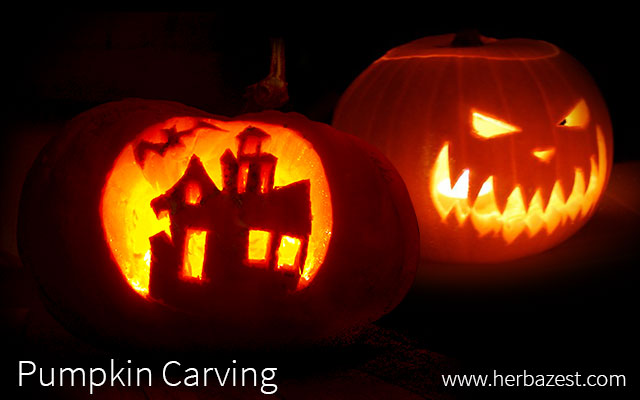Halloween pumpkin carving is a fairly recent phenomenon that varies greatly in its level of sophistication-- the finished products are now used for both the decoration of private family homes and for competitive ends.
History of Pumpkin Carving
The tradition of carving pumpkins can be traced 2,000 years ago to Celtic harvest celebrations that included the carving of tiny lanterns, which were placed on porches and doorsteps to welcome ancestors and ward off evil spirits. Irish immigrants continued the tradition in the Americas, replacing the original turnips and gourds with pumpkins, which were larger and native to the region.
Best Pumpkins for Carving
The best pumpkins for carving are those that are uniform in their color and appearance, free from bruises and abrasions, and have sturdy stems. Small and medium pumpkins of between 5 - 15 pounds (2 - 7 kg) that can sit up on their own - such as 'Jack-o;-Lantern', 'Spirit', 'Autumn Gold,' 'Harvest Moon,' 'Spooktackular,' and 'Baby Bear' varieties - are among the best and most widely available for pumpkin carving.
Carve Your Own Jack O' Lantern
Halloween pumpkin carving is a fun activity that can be enjoyed by the whole family. You can find great pumpkin carving examples online. Once you choose a theme, just follow the next easy steps:
Gather newspaper, carving tools, and a large spoon to help with gutting the pumpkins.
Cut a large enough circle or hexagon around the stems for a hand to pass through. Cut at an angle so as to prevent the tops from falling down back into the pumpkins.
Remove all flesh and seeds.
Carve fun or spooky Halloween pumpkin faces, gently poking out any unneeded pieces.
Finally, choose a method of lighting or preserving your carved pumpkin.
Other Nice Pumpkin Carvings
More intricate designs and methods of carving are possible using stencils, and specialized carving equipment can be easily bought from online retailers. Follow the same basic approach for gutting the pumpkin, then use a transfer tool to trace the desired patterns from both online and homemade templates. Imagination has no limits, and even a freaky image of a pumpkin eating a pumpkin is possible.
Pumpkin Carving Safety
The use of special kits is recommended, since they are specifically-designed for making great pumpkin carvings while reducing the risk of injuries related to the task. Additionally, using a battery-operated tea candle to light the finished pumpkin is safer than using an open flame.
Preserve Your Carved Pumpkin
Uncontrollable factors like rain, cold weather, and animals may threaten the longevity of carved pumpkins. However, the easiest way to decrease moisture and block the spread of mold is submerging them in a bleach solution for at least eight hours and then applying a commercial spray.
Before purchasing a specimen, a smart pumpkin carver will also remember to pay attention to the ripeness and general appearance of the pumpkin, as one that is overripe, rotting, or punctured will have a shorter lifespan.
Carved Pumpkin Contests
There's a whole lot more to Halloween pumpkin carving than just letting them rot on the front porch while the neighborhood squirrels feed on them. Artists and crafters take pleasure in designing intricate patterns and silhouettes on their pumpkins to have them showcased or judged for prizes.
Pumpkin festivals, Halloween carnivals, and county fairs are among the best places to witness or participate in a pumpkin carving contest - though more and more contests are being judged electronically.
Carved Halloween pumpkins have grown in popularity, quickly becoming an inseparable component of the autumn season. Though it has changed a lot over the years, the tradition still holds the same magic and wonder as the ancient festival from which it was derived.
Sources
- American Society for Surgery of the Hand, Pumpkin carving safety
- Preventative Medicine, The safety of pumpkin carving tools, 2004
- The Colonial Williamsburg Foundation, Some Pumpkins! Halloween and Pumpkins in Colonial America
- University of Illinois, Extension, Pumpkins and More




